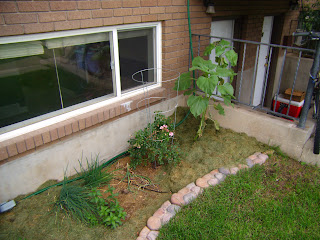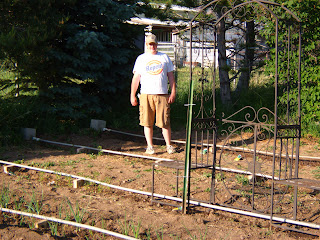We bottled our Walla walla onions using our pressure cooker. You've never smelled anything better than these onions right out of the pressure cooker! Wowzers! Super sweet! I seriously think this in my new favorite smell.
We used the following instructions we found on the internet:
According to the USDA, use onions of 1-inch diameter or less. Wash and peel onions. Cover onions with boiling water; bring to a boil. Boil 5 minutes. Pack the onions into hot jars, leaving 1-inch headspace. Add ½ tsp salt to pints; 1 tsp to quarts, if desired. Fill jars to within 1-inch from top with boiling water. Remove air bubbles. Wipe jar rims. Adjust lids and process.
Process in a Dial Gauge Pressure Canner at 11 pounds pressure OR in a Weighted Gauge Pressure Canner at 10 pounds pressure: Pints or Quarts:40 minutes
NOTE: Sea level pressure is 10 pounds. Pressure has to be increased as altitude increases by ½ pound per 1000 feet.
I believe since this paragraph was written, however, that sea level pressure has been changed to 11 pounds. Below, pictured is onions on the left, roasted peppers centered, and cucumber relish on the right.
Roasted Peppers (from Pesto Pressure Canner and Cooker Instructions and Recipes, 2010)
PEPPERS—HOT OR SWEET
(INCLUDING BELL, CHILE, JALAPEñO, AND PIMIENTO)
Preparation of Chile peppers—Cut two or four slits in each pepper, and blister using one of the following methods:
oven or broiler method: Place chile peppers in a 400° oven or broiler for 6 to 8 minutes until skins blister.
Range-top method: Cover hot burner, either gas or electric with heavy wire mesh. Place chilies on burner for several
minutes until skins blister.
Allow peppers to cool. Place in a pan and cover with a damp cloth. After several minutes, peel peppers. Remove stems and
seeds.
Preparation of other peppers—Remove stems and seeds; blanch 3 minutes.
Hot Pack: Small peppers may be left whole. Large peppers may be quartered. Pack peppers loosely in clean, hot Mason
jars, leaving 1-inch headspace. Cover with boiling water, leaving 1-inch headspace. Adjust jar lids.
Process at 11 pounds of pressure – Pints 35 minutes. For processing above 2,000 feet altitude, see page 11 for recommended
pounds of pressure.
Altitude and Pressure Chart for Canning Vegetables
Altitude
2,001 – 4,000 ft.
4,001 – 6,000 ft.
6,001 – 8,000 ft.
Processing time is the same at all altitudes.
Pounds of Pressure for Pints and Quarts
12 lbs.
13 lbs.
14 lbs.
I don't usually blister the peppers; the skins aren't tough enough out in Utah for this to be a concern. It's actually a lot harder to try to get the skins off, and they're not at all unpleasant to eat anyway.
Cucumber Relish
(from an old canning book such as a 'ball blue book')
12 lg. cucumbers peeled
4 lg onions
6 green peppers, stems and seeds removed
4 tsp each celery seed and mustard seed
1 tsp salt
1/2 tsp ground cloves
1 Tbsp ground turmeric
3 1/2 c. cider vinegar
2 1/2 c. sugar
Put the cucumbers, onions, and green peppers through a food chopper, using a medium blade or chop. In a 5 or6-quart saucepan, combine vegetables, celery seed mustard seed, salt,chives, turmeric, vinegar, and sugar. Quickly bring to boiling, stirring constantly; reduce heat and simmer for about 3 hours or until reduced to about 5 pints.
Prepare 5 pint-sized canning jars, following step 1 under Processing with a canner on page 31. (wipe rims, put heated lids on, etc.) Proceed with steps 3-9. Process for 15 minutes. Makes 5 pints. (Don't forget to adjust for altitude.)

Bread and Butter Pickles
6 cups sliced/chopped/speared cucumbers
Mix:
2 cups brown sugar
1/2 tsp turmeric (optional)
1/4 tsp ground cloves
1 Tbsp mustard seed
1/2 tsp celery seed or more
2 cups mild cider vinegar
Bring slowly to boiling point and boil 5 minutes
Put cut cucumbers in a jar, then fill with vinegar brine with 1/2 inch headspace. Clean the top of the jar, put lids on, and water-bath for 10 minutes. Adjust for Altitude.
1,001-3,000 ft = +5 minutes
3,001-6,000 ft = +10 minutes
6,001 - 8,000 ft = +15 minutes
Yield 4 pints. Store for 4-5 weeks+ before opening for best taste.
(as I was typing the original recipe, I realized I didn't follow even half of the instructions listed. So, I retyped the recipe to be what I actually do, and included correct water-bath instructions. The original recipe actually says you don't need to water bath it to seal it... so I must of gotten this recipe from an un-reliable source...)
Italian Tomato Sauce
Yield: about 7 pints or 3 quarts
4 quarts chopped, seeded, peeled, cored tomatoes (about 24 large)
1 cup chopped celery (about 2 stalks)
1/2 cup chopped onion (about 1/2 medium)
1/4 cup chopped green pepper (about 1/4 medium)
1 Tbsp basil
1 Tbsp oregano
1Tbsp minced parsley
2 tsp crushed red pepper (optional)
Combine all ingredients in a large sauce pot. Cover and cook 10 minutes, stirring occasionally to prevent sticking. Ladle hot sauce into hot jars, leaving 1 inch headspace. Remove air bubbles. Adjust two-piece caps. Process pints 20 minutes, quarts 25 minutes, at 10 pounds pressure in a pressure canner. (adjust for altitude.)
I tend to vary this recipe from week to week, depending on if I have celery, onion or peppers. Most weeks, I have left all 3 of those out, and added 1-2 cups of shredded zucchini to each quart jar. I also don't usually blanch (peel) my tomatoes or de-seed them when making it into sauce; rather, i run it through a food processor and can that extra fiber into my meal.
I've also noticed that tomato varieties play a large role in how runny your sauce is. Celebrity tomatoes tend to be very meaty, so there is no need to extract any juice before putting it through a food processor. Other varieties seem to have a lot of juice. Methods to take some of that extra juice out (and possibly can the tomato juice separately), is streaming the tomatoes in a juicer first; or, mashing quartered tomatoes in a colander while catching the juice in a bowl under it; or, after it's all been through a food processor, cooking it down in a pot for an hour or 3 (without the lid) so the extra juice can evaporate out, or else, in a crockpot (without a lid) over night. The last resort - say you've sealed that sauce into jars and it's still too runny - add that water/cornstarch combo to thicken that sauce right up, as you use your jars for dinner meals.

We have zucchini coming out of our ears, so we tried drying some zucchini for food storage. I did some sliced (for use in lasagna and meaty casseroles), and some grated (for use in spaghetti and casseroles). There's instructions out there for how to re-hydrate these veggies before, use, but I have yet to go look for those...
Lastly, I dried my cheyenne peppers. I got a needle and thread and just strung it through the peppers, then left them to hang in my kitchen. I don't have an A/C, so my kitchen is plenty warm enough for them to dry properly, but if yours isn't, or you're in a more humid area, hang them outside in the sun, or use a food dehydrator. Station the dehydrator outside your house, though, so you're eyes aren't burning in a couple of hours.
Drying (thin-skinned) Peppers and Chiles
Drying, Smoking, Powders, and Spice Blends
Drying is the oldest and most common way to preserve pepper pods and works well for most peppers—except for the very meaty ones such as jalapeños, which are smoke-dried and called chipotles (see below). To dry peppers, select those that have reached their mature colors, or are just starting to turn. If they are picked while still green, it is very likely that it will never turn the mature color. Avoid any pods that have black spots, because these will mold or rot. On dry days, the peppers can be placed on metal racks and set in the sun. Placing them on a surface that collects heat, such as a car hood or roof, accelerates the process. They can also be hung individually on a clothesline. Another method to use is a home dehydrator—just follow the manufacturer's instructions. Jalapeños and several other chiles will dry well in a dehydrator. Cutting the thick-fleshed chiles in half, or into several pieces helps to speed up the process. Some of the larger growers use forced convection solar dryers, which reduces the time for sun-drying by 65 percent.
Dehydration also works for fresh New Mexican or poblano peppers which are first roasted and peeled (either green or red), and then placed in the sun to dry. Lay long strips of the peeled pods on nylon window screening, cover them with cheese cloth, and place them in semi-shady location with good air circulation. The more humid the climate, the more sun that should be applied to the drying pods. This process makes chile pasado (chile of the past, see below), which will turn an unappetizing dark color, brown or almost black. However, when the chile pasado is rehydrated in water for about 30 minutes, it regains its green or red color. One ounce of this chile pasado is equivalent to ten to twelve fresh pods.












































